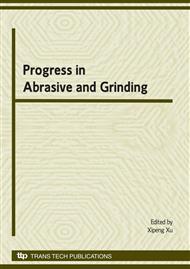p.33
p.45
p.61
p.69
p.77
p.85
p.97
p.103
p.113
Optimization of Cutting-Edge Truncation in Ductile-Mode Grinding of Optical Glass
Abstract:
The effect of cutting-edge truncation on the grinding mechanism of quartz glass as a hard and brittle material was investigated. From computer-aided grinding simulations and experiments on surface plunge grinding it was found that cutting-edge truncation decreases the ground-surface roughness and the maximum grain depth of cut; however, the maximum grain depth of cut approaches a constant value depending on the grinding wheel specifications. The alternative means of making the maximum grain depth of cut much smaller than this constant value is to increase the speed ratio. Cutting-edge truncation should be terminated at the optimum truncation depth to avoid the high grinding forces resulting from the flattening of cutting edges.
Info:
Periodical:
Pages:
77-84
Citation:
Online since:
January 2009
Authors:
Price:
Сopyright:
© 2009 Trans Tech Publications Ltd. All Rights Reserved
Share:
Citation:


